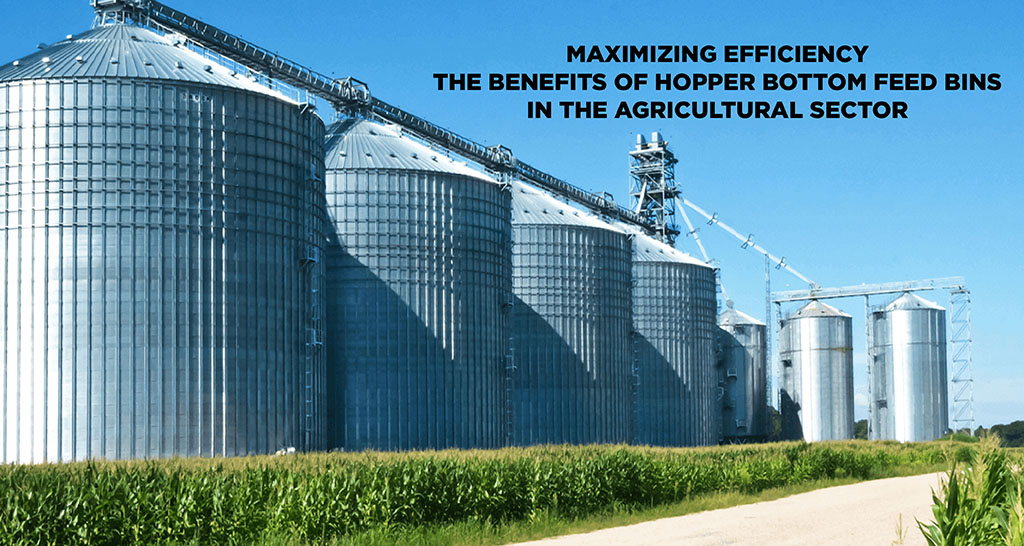Farm life is a non stop hustle– caring for animals, managing fields, and keeping everything running like clockwork. And what if there are other hidden time-wasters lurking in your feed storage, stealing those precious minutes you crave? Traditional flat-bottomed bins can lead to wasted feed stuck in corners, slow unloading times, and a constant battle against spoilage.
This is where hopper bottom feed bins step in the agricultural sector. These innovative bins, with their distinctive cone-shaped design, offer a game-changing approach to feed storage and management.
Today, in this article, we’ll delve into the numerous benefits of hopper bottom bins. We will showcase how they can revolutionize your farm’s efficiency, minimize waste, and, ultimately, contribute to the well-being of your animals. So, keep reading to the end!
Faster Unloading Speeds
Every minute spent wrestling with stubborn feed bins is a minute stolen from more productive tasks. Traditional flat-bottomed bins often require manual scooping or rely on unreliable vibration mechanisms to remove the last remnants of feed. It translates to wasted time, labor, and, ultimately, money.
Hopper bottom bins, on the other hand, with their innovative cone-shaped design, offer a solution. Gravity takes center stage, ensuring a smooth and complete flow of feed and eliminating the need for extra effort. Faster unloading speeds mean less time spent refilling feeders and more time dedicated to caring for livestock. It eventually helps optimize your farm’s efficiency and maximize your return on investment.
Maximized Storage
Traditional grain bins often come in limited size options, forcing you to choose between under-capacity and overspending. Hopper-bottom bins offer a solution with their adaptable design. Their conical shape allows for maximized storage within a given footprint, compared to flat-bottomed bins, where corners and flat surfaces steal valuable space.
This translates to a wider range of storage capacities. Mini hopper bottom bins are perfect for smaller farms or those needing to store specific feed types. For larger-scale needs, hopper bottom bins come in 6 or 7-foot diameters, accommodating from 2.9 to 10.8 tons of grain. Need even more capacity? Hopper bottom bins can reach a diameter of 9 feet, offering a massive storage capacity of nearly 22 tons.
But remember, size brings impressive storage, and so does the price tag, especially for larger models. So, to find the best deal, consider comparing prices from multiple suppliers or exploring online marketplaces that offer a grain bin for sale from a variety of manufacturers. This allows you to compare features, capacities, and, most importantly, pricing to find the perfect hopper bottom bin for your needs and budget.
Note: Remember, these versatile bins are available from a variety of agricultural equipment suppliers, so research and find the perfect fit for your operation!
Efficient Inventory Management
Hopper bottom feed bins offer a significant advantage in efficient inventory management for the agricultural sector. Their design allows for near-total removal of stored products. This minimizes waste and ensures you have an accurate picture of your on-hand inventory.
Furthermore, the gravity-fed design promotes a “first-in, first-out” flow. This helps maintain the quality of your crops by ensuring older grain isn’t buried beneath newer harvests, reducing the risk of spoilage.
By minimizing waste and ensuring accurate inventory levels, hopper bottom bins contribute to better decision-making around harvest storage, sales, and future planting needs.
Enhanced Hygiene and Rodent Control
The benefits of these feed bins extend beyond efficient inventory management. Their design fosters a cleaner and healthier environment for livestock and stored feed.
The conical shape minimizes areas where feed can stagnate, reducing the risk of mold growth and spoilage. Smooth, sloped sides and a central discharge point simplify cleaning and sanitation of the hidden corners, promoting better hygiene and reducing bacterial contamination.
Additionally, the elimination of ledges and corners removes ideal hiding spots for rodents, making them less likely to infest the bin and potentially spread disease. Some hopper bottom bins even feature ventilation systems that improve airflow and further control moisture levels, preventing mold growth and enhancing overall feed quality.
Cost-Effectiveness in the Long Run
While the upfront cost of hopper bottom feed bins may seem higher compared to flat-bottomed bins, their design offers significant advantages that translate to long-term cost-effectiveness. Here’s how:
Reduced Waste: Complete discharge through the central gate eliminates residual feed trapped in corners, minimizing waste and ensuring you get the most out of your purchased feed. This translates to lower overall feed costs over time.
Durability: Hopper bottom bins are often constructed from robust materials like galvanized steel, ensuring long-lasting performance and reducing the need for frequent replacements.
Lower Labor Costs: The easy-flow design and complete discharge eliminate the need for manual scooping or laborious cleaning. This ultimately saves their valuable time and labor costs associated with traditional flat-bottomed bins.
While the initial investment may be higher, the long-term benefits of hopper bottom bins contribute to significant cost savings for agricultural operations.
Wrapping Up
We hope you now understand why hopper bottom bins are a compelling choice for agricultural storage. So, hop on board with hopper bottom bins and unlock a world of benefits for your crops. With maximized returns and season-long safeguards, elevate your farming experience and reap the rewards of smart storage solutions.







